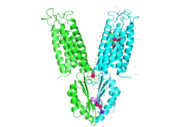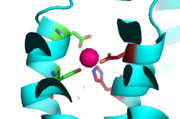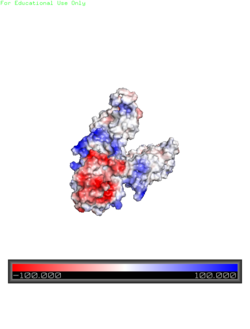Sandbox Reserved 1069
From Proteopedia
| Line 34: | Line 34: | ||
[[Image:Yiip_Electrostatic.png|250px|left|thumb|Electrostatic Charge Distribution]]<scene name='69/694234/Electro/1'>Charge distribution</scene> along the exterior surface of the protein is primarily neutral for the TMDs, but transitions to positive near the location of the charge interlock and interior side of the cell membrane. This positive section is characteristic of trans-membrane proteins as a means of achieving proper orientation within the cell membrane. Binding sites A, B, and C, as well as the CTDs of both monomers, all possess a high negative charge relative to the other charges present, facilitating the binding and releasing of Zn<sup>2+</sup> ions. The two CTDs are held together by the charge interlock and hydrophobic interactions of the TMDs, despite their electrostatic repulsion. Upon the release of Zn<sup>2+</sup> ions, the CTDs undergo alterations to electronegativity, which enables domain separation. | [[Image:Yiip_Electrostatic.png|250px|left|thumb|Electrostatic Charge Distribution]]<scene name='69/694234/Electro/1'>Charge distribution</scene> along the exterior surface of the protein is primarily neutral for the TMDs, but transitions to positive near the location of the charge interlock and interior side of the cell membrane. This positive section is characteristic of trans-membrane proteins as a means of achieving proper orientation within the cell membrane. Binding sites A, B, and C, as well as the CTDs of both monomers, all possess a high negative charge relative to the other charges present, facilitating the binding and releasing of Zn<sup>2+</sup> ions. The two CTDs are held together by the charge interlock and hydrophobic interactions of the TMDs, despite their electrostatic repulsion. Upon the release of Zn<sup>2+</sup> ions, the CTDs undergo alterations to electronegativity, which enables domain separation. | ||
| - | ==Zn<sup>2+</sup> Induced Conformation Change== | + | ===Zn<sup>2+</sup> Induced Conformation Change=== |
| - | Conformation changes occur in the TMD and CTD, both of which are heavily influenced by the presence of Zn<sup>2+</sup>. The conformation change directly involved with Zn<sup>2+</sup>/H<sup>+</sup> antiport occurs in the TMD as helix pivoting controls what environment site A is available to. Conformation change occurs when the transmembrane helix pairs TM3-TM6 pivot around cation binding site. It is believed that the energy for TMD conformation change comes from energy of binding each substrate. Changing to the outward from the inward-facing conformation causes a shift in TM5 which disrupts the tetrahedral geometry of active site A. This in turn decreases binding affinity site A has for Zn<sup>2+</sup> | + | Conformation changes occur in the TMD and CTD, both of which are heavily influenced by the presence of Zn<sup>2+</sup>. The conformation change directly involved with Zn<sup>2+</sup>/H<sup>+</sup> antiport occurs in the TMD as helix pivoting controls what environment site A is available to. Conformation change occurs when the transmembrane helix pairs TM3-TM6 pivot around cation binding site. It is believed that the energy for TMD conformation change comes from energy of binding each substrate. Changing to the outward from the inward-facing conformation causes a shift in <scene name='69/694233/Transmembrane_helix_5/2'>TM5</scene> which disrupts the tetrahedral geometry of active site A. This in turn decreases binding affinity site A has for Zn<sup>2+</sup> making export to the periplasm possible. After Zn<sup>2+</sup> is exported and site A is either empty or bound to hydrogen change back to the inward-facing conformation is favored. |
In contrast the main purpose of conformation change in the CTD is to stabilize the YiiP dimer and acts as a Zn<sup>2+</sup> sensor. This is possible because of the flexible loop that links the TMD and the CTD. This loop harbors the charge interlock which serves as a hinge that allows movement of the CTD. Using FRET to measure the distance between the CTD of each monomer fluorescence quenching was observed as the concentration Zn<sup>2+</sup> increased, which supports that idea that Zn<sup>2+</sup> induces a stabilizing conformation change in the CTD. | In contrast the main purpose of conformation change in the CTD is to stabilize the YiiP dimer and acts as a Zn<sup>2+</sup> sensor. This is possible because of the flexible loop that links the TMD and the CTD. This loop harbors the charge interlock which serves as a hinge that allows movement of the CTD. Using FRET to measure the distance between the CTD of each monomer fluorescence quenching was observed as the concentration Zn<sup>2+</sup> increased, which supports that idea that Zn<sup>2+</sup> induces a stabilizing conformation change in the CTD. | ||
| Line 42: | Line 42: | ||
YiiP's ability to export Zn<sup>2+</sup> from the cytoplasm is best described as an alternating access mechanism with Zn<sup>2+</sup>/H<sup>+</sup> antiport. YiiP has 2 major structural conformations as shown by the crystallized structures [[3H90]] and [[3J1Z]] (a YiiP homolog derived from ''Shewanella oneidensis''). 3H90 shows YiiP in its outward-facing conformation and 3J1Z shows the YiiP homolog in an inward-facing conformation. | YiiP's ability to export Zn<sup>2+</sup> from the cytoplasm is best described as an alternating access mechanism with Zn<sup>2+</sup>/H<sup>+</sup> antiport. YiiP has 2 major structural conformations as shown by the crystallized structures [[3H90]] and [[3J1Z]] (a YiiP homolog derived from ''Shewanella oneidensis''). 3H90 shows YiiP in its outward-facing conformation and 3J1Z shows the YiiP homolog in an inward-facing conformation. | ||
| - | When YiiP is saturated with Zn<sup>2+</sup> it seems to favor the | + | When YiiP is saturated with Zn<sup>2+</sup> it seems to favor the <scene name='69/694233/Outward-facing_conformation/2'>outward-facing conformation</scene> whereas when active sites are either empty or bound to H<sup>+</sup> the <scene name='69/694233/Outward-facing_conformation/1'>inward-facing conformation</scene> is favored. This drives the export of Zn<sup>2+</sup> from the cytoplasm and enhances the coupling of the proton-motive force. Although YiiP exists as a homodimer both monomers can undergo conformation change independent of one other to |
| + | produce the alternating access mechanism. | ||
== References == | == References == | ||
<references/> | <references/> | ||
Revision as of 21:30, 29 March 2017
Introduction
Zinc transporter is an integral membrane protein found in the membrane of Esherichia coli. YiiP is a member of the cation diffusion facilitator family. Members of this family occur all throughout the biological realm. These diffusion facilitators export divalent transition metal ions from the cytoplasm to the extracellular space [1]. They work to regulate the amount of divalent metals inside of the cell, which is biologically relevant because while these metals are necessary for different biological functions, they can prove fatal to the cell in excess amounts. Zinc is essential for the growth and development of cells and zinc levels can affect everything from gene expression to immune response. While YiiP is an integral membrane protein in the cells of Escherichia coli, understanding the mechanism of regulation behind it can help researcher's better understand the cation diffusion facilitator equivalents in eukaryotic cells.
| |||||||||||




